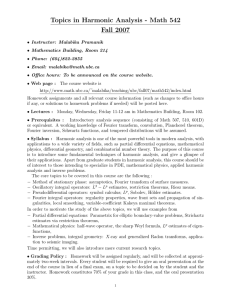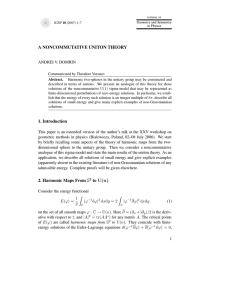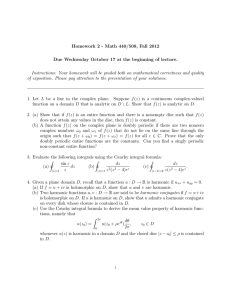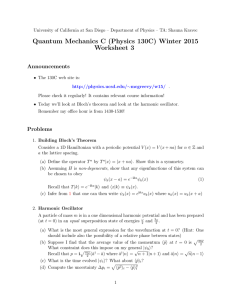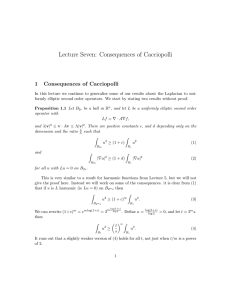Lecture Six: More General Operators
advertisement
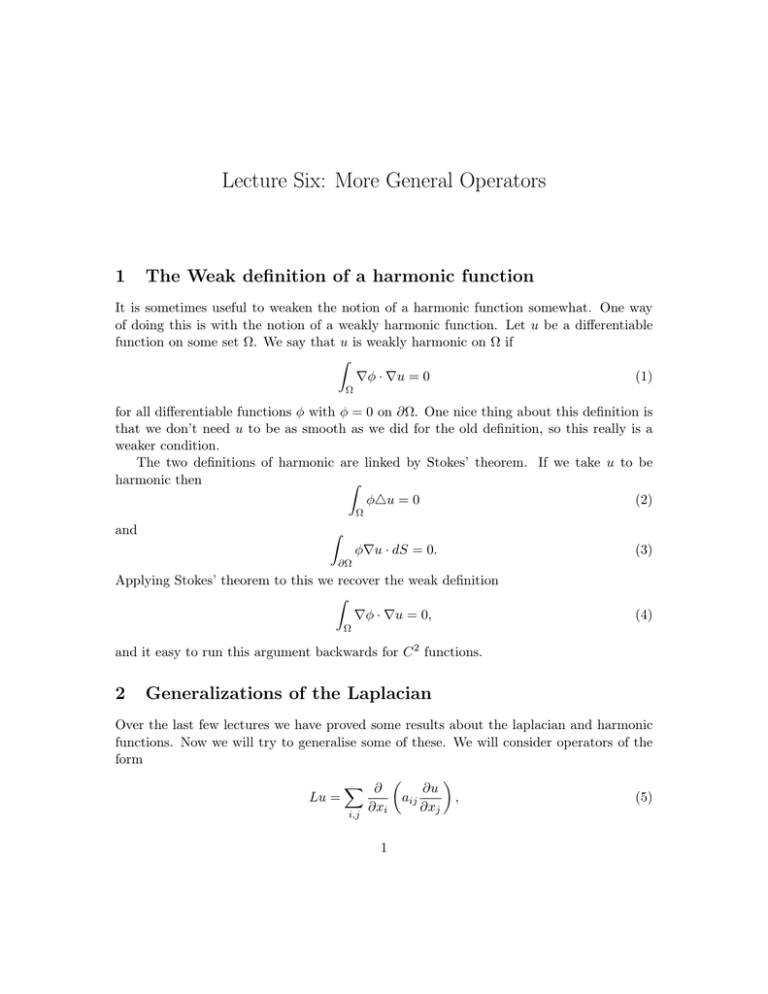
Lecture Six: More General Operators 1 The Weak definition of a harmonic function It is sometimes useful to weaken the notion of a harmonic function somewhat. One way of doing this is with the notion of a weakly harmonic function. Let u be a differentiable function on some set Ω. We say that u is weakly harmonic on Ω if � �φ · �u = 0 (1) Ω for all differentiable functions φ with φ = 0 on ∂Ω. One nice thing about this definition is that we don’t need u to be as smooth as we did for the old definition, so this really is a weaker condition. The two definitions of harmonic are linked by Stokes’ theorem. If we take u to be harmonic then � (2) φ�u = 0 Ω and � φ�u · dS = 0. (3) ∂Ω Applying Stokes’ theorem to this we recover the weak definition � �φ · �u = 0, (4) Ω and it easy to run this argument backwards for C 2 functions. 2 Generalizations of the Laplacian Over the last few lectures we have proved some results about the laplacian and harmonic functions. Now we will try to generalise some of these. We will consider operators of the form � � ∂ � ∂u Lu = aij , (5) ∂xi ∂xj i,j 1 where A is a symmetric n by n matrix with entries aij (not necessarily constant). An operator written like this is said to be in divergence form since Lu = div(A�u). Note that if A is the identity matrix then L is simply the laplacian. We will often be interested in functions satisfying Lu = 0. Such functions are called L­harmonic. There is also the concept of a weakly L harmonic function, where � �φ · (A�u) = 0. (6) Ω by a similar argument to section 1 any L­harmonic function is weakly L­harmonic. 2.1 Uniformly Elliptic Operators Operators where the matrix A satisfies λ|v|2 ≤< Av, v >≤ Λ|v |2 for some real 0 < λ ≤ Λ and for all vectors v are of particular interest. These operators are said to be uniformly elllptic. If there is a lower bound but not an upper bound the operator is simply said to be elliptic. We can extend many of the results we proved for harmonic functions to functions solving any uniformly elliptic operator. 2.2 The Cacciopolli Inequality for uniformly elliptic operators The first result that we will generalise is the Cacciopolli inequality. This is almost exactly the same inequality as for harmonic functions. Theorem 2.1 If L is uniformly elliptic with λ|v|2 ≤< Av, v >≤ Λ|v |2 and u satisfies uLu ≥ 0 on B2r then � � 4Λ2 2 |�u| ≤ 2 2 u2 . λ r B2r \Br Br Proof Again we start off by introducing a test function φ with φ ≥ 0 and φ = 0 on the boundary of B2r . Calculate � φ2 uLu 0 ≤ �B2 r φ2 u(� · A�u) ≤ B2 r � < �(φ2 u), A�u > ≤ − B2 r � ≤ −2 � φu < �φ, A�u > − B2 r B2 r 2 φ2 < �u, A�u > by Stokes’ theorem. Therefore � � 2 λ φ < �u, �u > ≤ −2 B2 r φu < �φ, A�u > (7) B2 r by uniform elipticity. Now now work on the right hand side; � � 2 φ < �u, �u > λ ≤ −2 φu < �φ, A�u > B2 r �B2 r ≤ −2 � ≤ |2 < u�φ, φA�u > B2 r < u�φ, φA�u > | B2 r At each point A is a real symmetric matrix with positive eigenvalues, so it defines a good norm. Therefore we can apply Cauchy­Schwarz twice to the last line to get � 2 φ < �u, �u > λ � (< u�φ, uA�φ >< φ�u, φA�u >)1/2 ≤ |2 B2 r (8) B2 r �1/2 �� < u�φ, uA�φ > �� ≤ 2 �1/2 . < φ�u, φA�u > (9) B2 r B2 r Applying uniform ellipticity and rearranging gives � �1/2 �� u < �φ, �φ > �� 2 2 φ < �u, �u > ≤ 2Λ λ B2 r B2 r �1/2 φ < �u, �u > . (10) 2 B2 r Divide and square to get λ2 � φ2 |�u|2 ≤ 4Λ2 � B2 r u2 |�φ|2 . (11) B2 r Now pick φ and proceed exactly as we did for the previous Cacciopolli Inequality i.e. let � 1 if |x| ≤ r; φ(x) = . 2r−|x| if r < x ≤ 2r r Then � 2 |�u| � ≤ Br ≤ φ2 |�u|2 B2 r � 4Λ2 λ2 4Λ2 ≤ 4 2 2 λ r as required. 3 u2 |�φ|2 B2 r � B2r \Br u2



